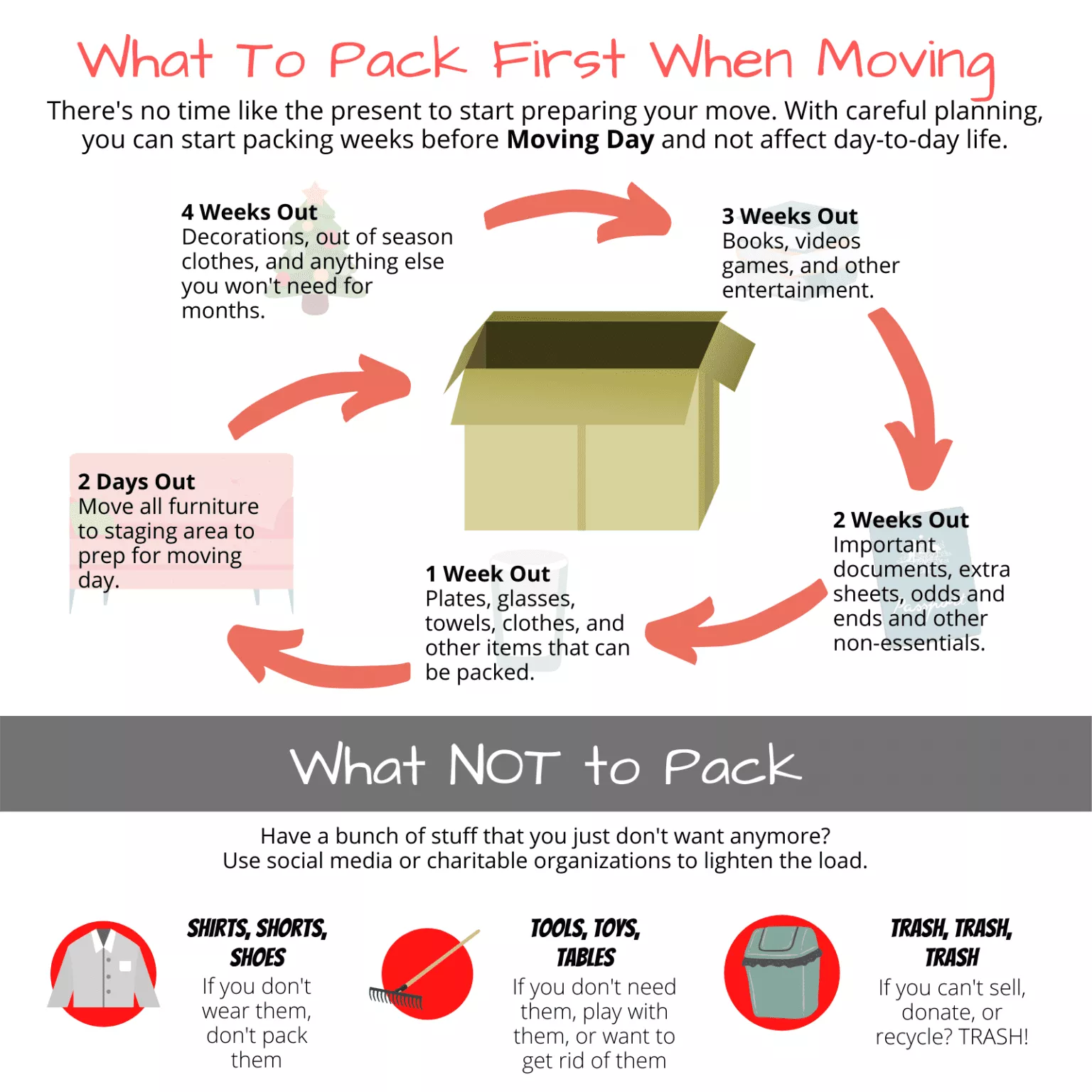Starting to move requires good planning and organising to make sure the change to a new house happens without stress. This list for moving will be your detailed guide, dividing the process into steps that are easier to handle. From the beginning of planning to when you are finally comfortable in your new place, every step is made to help guide you through the complicated parts of relocating. We start with the important early steps for moving.
Step 1: Preliminary Planning
In the first step, you must decide on important things like when to move, how much money you can spend, and whether to hire moving experts or do it yourself. Let us guide you through the key points and planning that will help make your relocation go smoothly without any stress. Let’s delve into the key aspects of setting the stage for a successful relocation.
1. Decide Moving Date:
Choosing the best date to move is particularly important for a smooth change to your new house. Start by thinking about your job responsibilities, family plans, and rental contracts. Consider the possibility of getting services to help you move, particularly if you wish to employ experts. If you choose a suitable date early enough, it sets a foundation for organising and carrying out your move effectively.
Consider the following:
- Work Schedules: Schedule the relocation for a period when you and your helpers are available to take leave.
- Lease Agreements: Make sure you move on the date your current lease finishes to not pay extra charges.
- Availability of Moving Services: Ensure you can find moving companies and moving trucks for the date you have decided on.
- Preparation Time: Select a date that provides ample time for packing and preparation.
2. Set up Budget:
Building a practical budget is key to having a smooth and worry-free relocation. Spend ample time evaluating your finances carefully, and include every possible cost related to the moving journey. Key components to consider include:
- Packing Supplies: Estimate the cost of boxes, tape, bubble wrap, and other packing materials.
- Moving Services: For moving, if you choose a company to move your things or rent a truck by yourself, remember to consider the expenses.
- Transportation: Account for the cost of renting a truck or other transportation methods.
- Unforeseen Expenses: Set aside a contingency fund for unexpected costs or emergencies.
A carefully planned budget makes sure you are ready financially and helps you make knowledgeable choices while moving.
3. Choose Moving Option (Professional vs. DIY):
Choosing whether to employ professional moving services or manage the move on your own needs a thoughtful assessment of your situation. Think about these aspects:
- Consider how much help you can receive from friends and relatives compared to the ease of hiring expert moving companies.
- Check how much time you have before while doing, and after your relocation. Hiring experts can make things go faster.
- Think about how much effort you can comfortably handle, and the detailed planning needed if you decide to move by yourself.
- Find out the prices from different companies that help with moving, including how much it is to rent a truck, pay for gas, and any extra services you might need.
When you think about these points carefully, it helps you choose wisely in a way that fits your situation and makes sure your move goes well.
You can also check: Moving Offices? Here’s Your Comprehensive Checklist
Step 2: Sorting and Decluttering
Moving to a different home and starting a new chapter requires clear thinking and being organised. We will guide you on how to organise and remove unnecessary items for an easier move to your new house.
1. Assess Belongings:
Reviewing what you own is especially important when getting ready to move. You must consider carefully if each thing is needed or has emotional importance. Here’s how to approach this assessment:
- Necessity: Consider if each item is useful and practical. The question is whether the item has a function and if it justifies the work to transport it.
- Emotional Importance: Understand the feelings connected to belongings. Sentimental things have worth, but it’s important to choose which ones carry deep importance.
- Streamlining: This evaluation helps in making choices on what to hold onto, what to get rid of, and what to give away. It makes sure you move with things that match your present requirements and way of living.
B. Decide on Keep, Donate, Sell, or Discard:
When you sort things according to what you think, it makes packing easier and helps with beginning again in a new place. This is how to choose:
- Keep: Maintain possession of things that serve an important purpose or have sentimental value. These items will make your new living space better.
- Give away: Keep out things that are still fine, but you don’t need anymore. Things like wearables, pieces of furniture or stuff for the house can help other people.
- Sell things: When you own things that others might want to buy and you are okay with making the effort, think about selling those items. Doing this can help pay for some of your moving expenses and make it so there’s less stuff for you to take with you when moving.
- Discard: Throw away things that don’t work, are in bad shape, or you don’t feel emotionally attached to them anymore. This makes you move much lighter.
3. Organise Garage Sale or Online Listings:
If selling items is part of your plan, effective organisation is key:
- Garage Sale: Set the date, promote it early, and arrange goods for showing. Proper item pricing can increase sales and reduce what you must carry away afterwards.
- Online Platforms: Use internet sites to connect with more people. Take good pictures, write true details about your products and choose reasonable prices for the things you are selling.
- Reduction of Items: Successful sales help increase the money for your move and decrease the number of things you must pack and carry.
4. Donate Unwanted Items:
Contributing to your community through donations is a positive step in simplifying your move:
- Find groups in your area that take gifts and share your beliefs. Talk to them so you can plan how to deliver or have them collect the donations.
- Plan when to give things away so it matches with the time you move. This way, items you don’t need anymore can go to others and make your move easier because there is less stuff.
- Benefits include making your move easier and helping others who lack essentials, which creates a feeling of togetherness and kindness.
Step 3: Gathering Packing Supplies
The step of gathering packing supplies is pivotal to ensure the safe and organised transport of your belongings. Adequate preparation and having the right materials contribute significantly to a smooth moving experience.
1. Collect Various Box Sizes:
When you get ready to move, it is very important to have many different sizes of boxes. Things in your home are not the same size, and they can be heavy or break easily. To address this diversity effectively:
- Small Boxes for Heavy Items: Use little boxes for packing things that are heavy like books, kitchen stuff, or small machines. It makes the boxes easier to carry and less likely they will break.
- Large Boxes for Lighter Items: Use big containers for things that are not heavy but take up a lot of space, like blankets, cushions or clothes. It helps to use the space well and stops small boxes from getting too full.
- Medium Boxes for Moderate Items: Boxes of medium size are suitable for items with a moderate weight, such as decorations from the house or food that does not spoil. They make it easier to spread the weight in an even way.
The strength of your boxes is very important for keeping your things safe when you move. This is why strong boxes are necessary:
- Prevent Damage: Strong boxes act as a shield for your things, lessening the chance of harm while moving. This is very important for items that are fragile or can easily break.
- Integrity During Handling: Strongboxes keep their shape well, so they can handle being moved around a lot when you load them, unload them, and move them from place to place.
- Reinforcement for Heavy Items: For items that are heavy or breakable, make the boxes stronger by putting more tape on them or giving extra support. This added step gives more safety and reduces the risk of the box breaking.
Fundamentally, gathering boxes of different sizes, from the smallest to the biggest ones, and making sure they are strong is very important for a move that is both neatly arranged and secure. This careful planning helps protect your items and makes the moving process run smoothly without much worry.
2. Buy Packing Tape, Bubble Wrap, Packing Paper, Labels:
To make sure your things are protected while you move, it is important to gather all the necessary packing supplies.
- Get enough good packing tape. It helps to close boxes well, so they do not open when moving.
- To keep delicate things safe, wrap them with bubble wrap. It adds extra padding to stop items from breaking.
- Use paper for packing to cover things, which keeps them safe from scratches and marks. It is incredibly good for items that have sensitive surfaces.
Make sure to write on each box what is inside and which room it should go into. By doing this, you can unpack in an orderly way, helping you to save time and work less hard.
3. Consider Furniture Blankets or Moving Pads:
For the safe transportation of furniture, considering furniture blankets or moving pads is beneficial:
- For protecting furniture while moving, it is good to use blankets or pads for covering. They help prevent scratches and small damage when the furniture is being transported.
- Wrap big items like furniture with these safety blankets and use packing tape to keep them tight. This extra cover protects your furniture from knocks and hits.
- Furniture blankets and moving pads can be used many times, which is good for saving money and protecting the environment while keeping your furniture safe.

Step 4: Start Packing
This phase requires strategic organisation and attention to detail to safeguard your possessions during the move. In this step, we guide you on where to begin, how to label effectively, and the importance of a moving day essentials box.
1. Begin with Non-Essential Items:
- Initiate the packing process with non-essential items to create a systematic foundation:
- Pack the things you will not need right away in your new house, like items for different seasons or things you do not use often.
- Begin by organising and packing items that are not essential, so you can focus on the important things as you continue with the move.
2. Label Boxes Clearly (Contents and Destination Room):
Clear labelling is crucial for an efficient unpacking process:
- Write clearly on each box what is inside and which room it should go to. This makes finding things faster when you are unpacking.
- Provide short explanations of what is inside every box for deciding which ones to open first depending on urgent necessities.
- Please mark which room each box will go to in the new house so that those who are moving them can do it quickly.
3 . Pack Moving Day Essentials Box:
Create a box with all the important things you need for the first day in your new house, so you can easily reach them when you get there.
- Toiletries: Include essential personal hygiene items such as toothbrushes, toothpaste, soap, and towels.
- Medications: Pack necessary medications in a clearly labelled and easily accessible container.
- Essential papers: Keep items like identity proofs, health documents, and any related moving forms in a safe yet easy-to-reach place.
For each person in the family, it is good to take an extra set of clothes so everyone can feel comfortable on our first day at our new house.
4. Rent Moving Trucks and Vans:
Ensure a smooth transport process by renting suitable vehicles:
- Choose the right size of moving truck or van depending on how much stuff you have. Pick a vehicle that can hold all your things well, so you don’t have to make extra trips.
- Book your rental transport early to make sure it’s available when you plan to move.
- If needed, ask for more things like dollies or ramps which help with putting in and taking out stuff.
When you include renting trucks and vans for moving during the time you are packing, it makes your entire process of shifting more organised and efficient. Explore the flexible rental options provided by Alpha Car Hire to ensure that you have the vehicle for the duration you need during the packing and moving process. Click here!
Step 5: Notify Important Parties
This step involves informing key entities about your impending move to guarantee continuity in services and connections. Join us in exploring the essential actions needed to update your address with the post office, financial institutions, utilities, and, of course, your circle of friends and family. Let’s ensure everyone is informed and your new address is well-established.
1. Inform Australia Post of the Change of Address:
- Make sure to tell the local post office when you move so there are no problems with your mail delivery.
- Go to the nearby Australia Post office or their online site and fill out a form for changing your address so that they can send your letters to where you move.
- Choose mail forwarding services to make sure all your important letters and packages arrive at your new home, which is crucial for keeping a steady flow of your postal deliveries.
2. Update Address with Banks, Utilities, and Insurance:
Make sure to update your address with important financial services and other necessary organisations.
- Notify Banks: Tell your banks that you have a new address. Make sure they have your current contact details, so you get bank statements and messages without delay.
- Utilities: You should get in touch with the companies that give you services like electric power, water and natural gas to tell them your new address. It will help move these services over to your new home without problems.
- Insurance Companies: For the insurance firms, like those for health and home, you must give them your new address. Then they can send you updates on your policy and other necessary messages.
- Update Billing Information: Make sure your billing information is up to date so there are no interruptions in your service. Updating on time helps everything run smoothly with payments and services connected to money.
3. Notify Friends and Family of the New Address:
- Stay connected with your social circle by informing them of your upcoming move:
- Tell the people close to you that you are moving. Give them your new address and if there is a change in how they can contact you, let them know this too.
- It is good to give your new address before you move so that friends and family can keep in contact with you. That way, they send letters or packages to the right place.
By taking the initiative to inform key people and making sure your address details are current, you help ensure a well-organised move in Australia.
Final thoughts
A good move depends on careful planning and doing things step by step. You need to choose the day you will move, decide how much money you can spend, and tell important people that your address is changing. Every part of this helps make the moving process go smoothly. If you are in Australia, it is important to change your information with organisations such as the postal service, financial institutions, energy providers and insurance companies.
Keep things in order, focus on the most important tasks first and make sure to talk clearly with others. When you get used to your new place of living, give yourself moments to discover the area and meet people who live nearby. The Moving Checklist acts as a guide for making sure your move goes well and marks the beginning of exciting new parts in life. I wish you a relaxed and joyful experience with your move!
Alpha Car Hire: Top Commercial Car Rental Company in Logan
In Logan, which is located in the South of Brisbane, Alpha Car Hire has become the best option for renting vehicles for business purposes. The following points explain why this is so:
- Wide selection of vehicles available: You can pick from different commercial vehicles, like utility trucks, bigger trucks and vans for moving according to what you require for transport.
- Reliable Service: Alpha Car Hire is recognised for its dedication to offering dependable and effective transport options, making sure you have a smooth experience.
- Well-Maintained Vehicles: Enjoy the advantages of properly kept vehicles, which help ensure a smooth and secure experience when renting for business purposes.
- Quality Service: Alpha Car Hire focuses on providing good services, making sure to pay attention to the customers’ needs for business transport.
Are you prepared to move without any trouble? Look at what Alpha Car Hire provides and see the unique experience!
Free Downloadable PDF Moving Checklist:
To further assist you in the moving process, we offer a comprehensive Moving Checklist in a convenient PDF format. This downloadable resource is designed to help you stay organised and ensure no crucial step is overlooked during your relocation.

What the PDF Includes:
- Detailed step-by-step guide for each phase of your move.
- Printable checklist to mark off tasks as you complete them.
- Tips and reminders for a smooth and stress-free relocation.
Make your move more efficient and organized by utilizing our Free Downloadable PDF Moving Checklist. Happy moving!
Alpha Car Hire: Streamlining Your Move
When it comes to efficient transportation for your move, Alpha Car Hire is your trusted partner, offering:
- Professional Assistance: Expert guidance in choosing the right vehicle for your needs.
- Convenient Locations: Multiple locations for easy access to their services.
- Flexible Options: Tailored rental plans to match your packing and moving timeline.
- Additional Equipment: Availability of tools like dollies and ramps for a smoother moving day.
- Reliability and Trust: A reputation for dependable service, ensuring a seamless transition.
Contact Alpha Car Hire:
Website: Alpha Car Hire
Contact: 1300 227 473
With Alpha Car Hire, your move becomes not just a relocation but a streamlined and stress-free journey.







